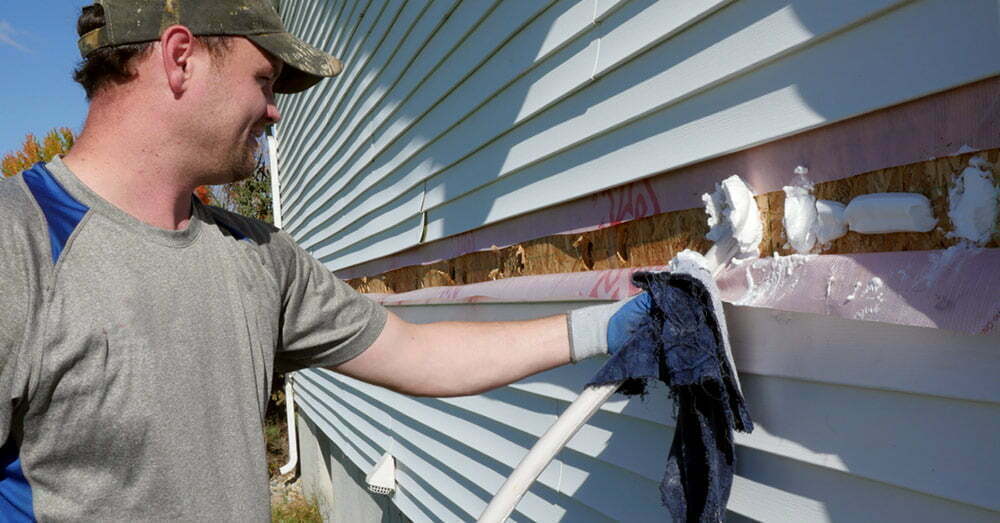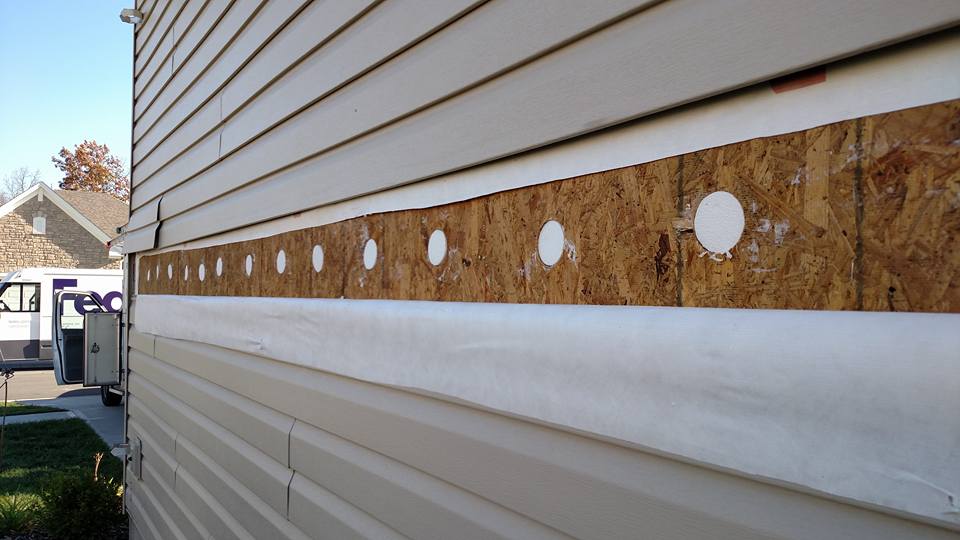Insulation plays a crucial role in enhancing the comfort and energy efficiency of our homes. Choosing the right type of insulation can be challenging, with numerous options available on the market but Cincinnati RetroFoam is here to help! One method that has increasingly gained attention is blown-in wall insulation – a process involving small particles of insulation material that are blown or sprayed into wall cavities for enhanced thermal performance.
Blown-in insulation is effective in limiting heat flow because it creates a thick layer of insulation covering gaps or crevices in the walls, floors, or attic of a building. In turn, this prevents the transfer of heat through conduction, convection, and radiation. This helps maintain a more comfortable and energy-efficient indoor environment.
Introduction to Wall Insulation
Wall insulation stands as a crucial aspect in any residential insulation framework. It provides a thermal resistance shield between the interplay of inner and outer atmospheric temperatures.
Insulation enhances the home improvement realm by ensuring a comfortable living environment, reducing energy bills, and driving up property value.
Understanding Wall Insulation
Insulation material comes in a wide variety, such as natural wool blown, spray foam insulation, mineral wool, and fiberglass insulation. These product types are chosen based on several considerations like the stud space available, climatic conditions, and cost. We recommend RetroFoam injection foam for wall insulation.
An essential factor to consider is the insulation’s form. There are significant differences between roll insulation, cellulose blown insulation, and blown-in wall insulation, although all serve the same purpose of filling up the wall cavities.
Blown-in Insulation: A Quick Overview
Blown-in wall insulation refers to a procedure where loose-fill fiberglass, cellulose, or mineral wool insulation is blown into the wall through a large hose. This process is typically supervised by professional insulation contractors.
Importance of Blown-in Wall Insulation to Homeowners
Blown-in insulation significantly improves a home’s energy efficiency and comfort levels. Moreover, it provides a tighter seal compared to traditional methods, thereby reducing the likelihood of energy losses.
Blown-in Insulation versus Traditional Insulation Methods
Traditional residential insulation techniques, such as roll insulation, often leave pockets of air due to the shape and the unevenness of the stud space. These air pockets weaken the insulation’s efficiency.
In contrast, blown-in insulation, whether it’s fiberglass, mineral wool, or cellulose blown, gets into every nook and corner, making it a superior choice to other methods.
How Blown-in Insulation Enhances Your Home’s Thermal Performance
Blowing insulation into wall cavities ensures complete coverage, thereby enhancing the R-value (the measure of thermal resistance). This comprehensive coverage blocks drafts, dampening sound transmission and resulting in a more comfortable home.
Potential Cost Savings and Energy Efficiency with Blown-in Insulation
The upfront wall insulation costs and attic insulation costs for blowing insulation might be higher than traditional methods. Yet, considering the energy efficiency, minimal maintenance, and prolonged lifespan, this insulation proves to be cost-effective in the long run.
Adjustments for square footage, labor costs, and additional costs related to installation complexities are also factors influencing insulation costs per square foot. If you’re looking for an accurate estimate, you can request a free quote on your project.
Installation And Maintenance of Blown-in Wall Insulation
Steps in the Installation Process of Blown-in Insulation
In the initial stages, insulation contractors assess the stud space in your residential structure to ascertain the suitable type and quantity of insulation material. Following the assessment, the process of blowing insulation begins. This technique is used to fill insulation material into wall cavities, enhancing the thermal resistance of your home. For demonstration purposes, let’s consider an instance where cellulose-blown insulation or fiberglass insulation is used.
The task of applying insulation material can vary in terms of difficulty. For example, blowing in cellulose insulation is usually less labor-intensive compared to injection foam insulation due to its lighter nature. However, the insulation costs of these different methods can fluctuate, including wall insulation costs and attic insulation costs. Installers will also consider the age of your home. If you live in an older structure with existing insulation, this may need to be removed before you can install blown-in insulation.
Maintenance and Longevity of Blown-in Insulation
Once installed, blown-in wall insulation generally requires minimal maintenance. However, ensuring a healthy lifespan for your insulation requires periodic checks to prevent moisture absorption and intrusion of pests. These factors can degrade the insulation’s thermal resistance, leading to higher energy bills.
Identifying When Your Insulation Needs Replacement
Knowing when to replace your blown-in wall insulation can save additional costs and protect your home. Signs of insulation deficiency include fluctuating indoor temperatures and a significant increase in heating or cooling costs. This typically indicates a reduction in insulating value and calls for a replacement.
Safety Aspect and Environmental Impact of Blown-in Wall Insulation
Apart from enhancing thermal resistance, blown-in wall insulation has environmental impacts and involves certain safety measures.
Safety Measures Linked With Blown-in Insulation
Working with blown-in insulation material mandates safety measures like wearing protective clothing, gloves, goggles, and a respirator to prevent inhalation of dust particles. Insulation contractors possess the expertise to safely handle and install these materials, so you should always invest in professional installation for this project.
Impact of Blown-in Insulation on the Environment
Many insulation materials like cellulose or natural wool can be eco-friendly choices. For instance, natural wool is a sustainable product, and cellulose-blown insulation is often made from recycled paper products.
Remember, choosing the right insulation product for your specific requirements can reap long-term benefits. Always consult with skilled insulation contractors for accurate commitment estimates based on your square footage and consider the labor costs in your total calculations.
Upgrading Your Home’s Thermal Performance
Investing in quality insulation is a pivotal aspect of home improvement. If you’re considering upgrading your current insulation or are in the process of a new build, blown-in wall insulation promises both immediate and long-term benefits. It fills the stud space efficiently, providing superior thermal resistance.
Look to Cincinnati RetroFoam for Your Insulation Project
If you need blown-in insulation to fill walls or attic spaces, Cincinnati RetroFoam is here to help. Since 2015, we’ve offered premium foam insulation to homeowners that isn’t available anywhere else. Our mission is to provide impeccable service and give our best at every job to give homeowners lasting comfort and long-term savings.
We offer a range of insulation services, including injection foam wall insulation. We work on existing homes, pole barns, and commercial properties. Whatever your insulation needs are, we’re here for you. We also offer financing options if you’re looking for ways to manage insulation costs. Let us serve as your trusted partner for your upcoming insulation project. Contact us today to get your free quote.
Frequently Asked Questions
Is blown-in wall insulation worth it?
When installed properly blown-in wall insulation can increase comfort, help you save on utility bills, and improve your home’s value. It’s always best to work with professional installers when investing in wall insulation.
Is too much wall insulation bad?
Too much wall insulation can insulate your home too much so there’s nowhere for any air to escape. Thankfully, when you invest in professional installation, you won’t have this problem.
How can you tell if your house is poorly insulated?
If your home is poorly insulated, you may notice signs like higher energy bills in the hot and cold seasons, constant temperature fluctuation, ice dams on your roof, or frozen pipes in freezing temperatures. If you notice these signs, it’s time to invest in professional insulation.


